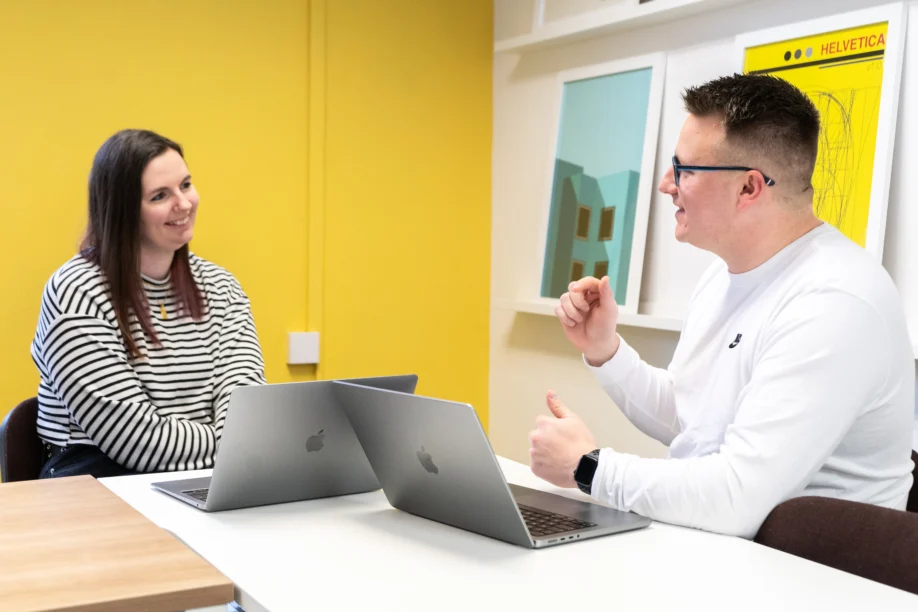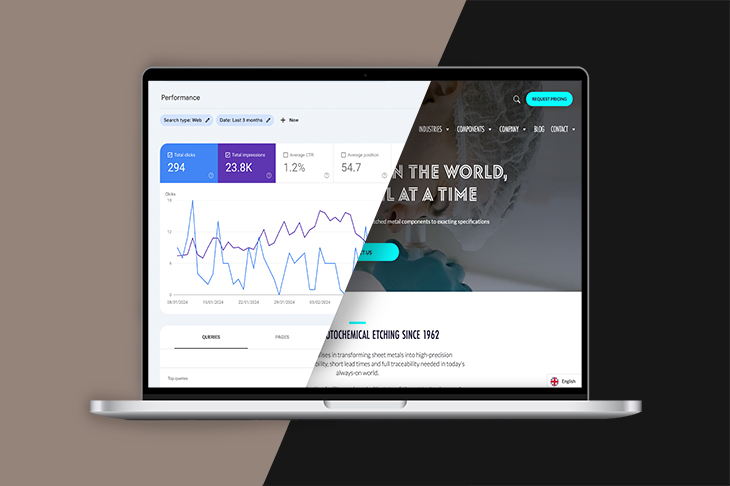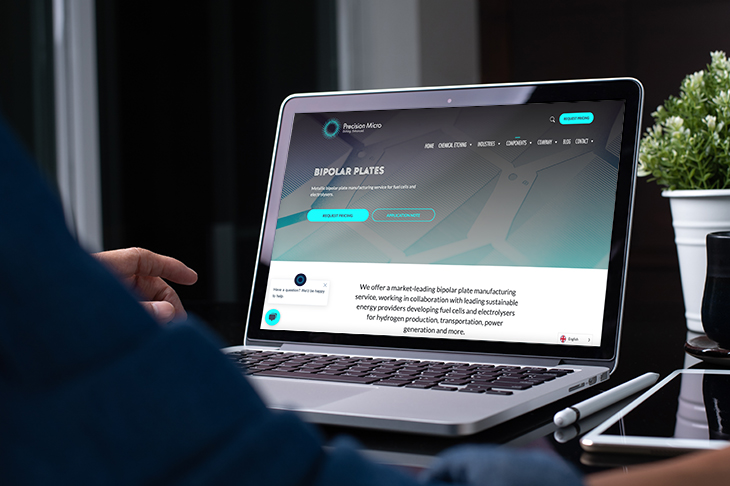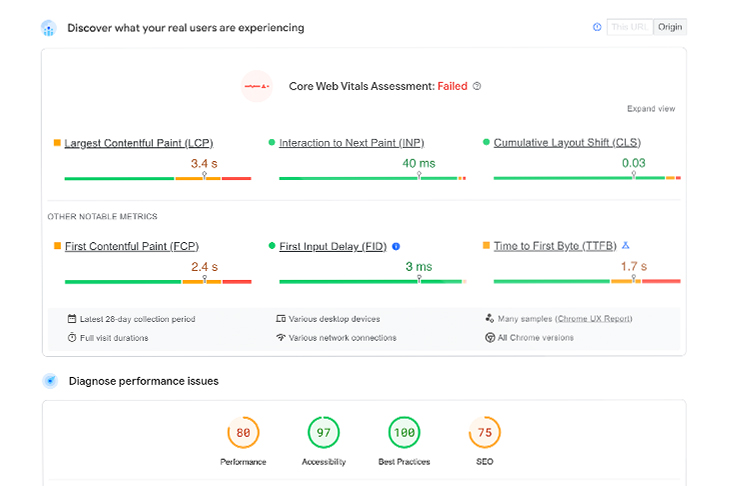- Digital Marketing
Web design and SEO: How to balance both without compromise.
Welcome. And now we see the marketeers and PR specialists step forward, centre ring to introduce our contestants. In the blue corner we have The SEOs. In the red corner we have The Designers. It’s the battle of the brains – both left and right. The clash of creativity with definitive data.

The relationship between SEOs and web developers and designers has long been a little tense – never brutal and unforgiving – just thwart with stubbornness. After all, real creatives and technical SEOs aren’t dissimilar – they’re specialist disciplines that we desperately need in the B2B marketing space. So when we’re facing a website project, whether an entirely new site or a website update, how do marketers manage the expectations on both sides and agree on a visually pleasing, logical route that does not compromise website performance and affect wider marketing efforts?
To answer this question, Jess Bott, our Digital Account Manager and Adam Sidaway, our Senior Designer got together to discuss the challenges both ‘sides’ face when tackling website design and SEO and how to overcome them.

What makes a good web design?
Adam: “To put it simply, good website design will never, ever compromise the site’s functionality and its ability to be ranked in search. Of course, there is a balance to be struck as the site must possess a certain flair, a certain level of creativity that embodies and emboldens the B2B brand. But as a designer, I think we must approach website design differently than any other creative project as we’re designing something to encourage instant interaction. Logic and reason must play into every creative decision to facilitate the user journey and drive conversions.
“So from my perspective, for example, the abstract visual that leads across B2B PR advertising campaigns may not work as a lead image on a website. Why? Well perhaps it will take too long to load? Or perhaps the user won’t know immediately what it represents and cannot find directional content easily? I’m still being creative, it’s just a more scientific method of approaching it which is challenging and exciting.”
Jess: “As an SEO, of course I want the websites I’m managing to be aesthetically pleasing – if a page looks shoddily put together with poor images and strange fonts, I’m going to see visitors leave almost immediately. The trick is to focus all design and SEO efforts into the end-user, it isn’t about what Adam wants to design, nor is it about a user-journey or heading structure that I’d ideally like to see. Everything needs to be optimised directly for the end-user as they should dictate design and functionality. This is where site audits and keyword research really come into their own as these are the first steps in building a picture of what the website could be – it enables us to understand the audience requirements far better and it allows us to design and build a site with them at the centre of our decision-making.”

Why is it important to design a website with SEO in mind?
“Let’s marry the two – we’re going to call it ‘SEO website design’ because the two must not be separate. You can, of course design a beautiful website – you’ve seen the sort – those that resemble an online brochure. But, without deploying SEO practices the site will not rank alongside competitors and users will not be able to discover your content.
“When we’re googling for information as consumers, we expect clear and accurate results. What do we want to find once we click through to a site? Ideally, a page layout that looks great but is also clear. Navigating the site easily and searching directly for what we’re after is also essential. Visually seeing the hierarchy of pages for us to go directly – or in two steps – to the content we need is a must. Taking action or getting in touch should be effortless, regardless of the device being used. If design, SEO and content marketing teams are all focused on achieving these goals, the website will be fit for purpose.”
B2B website design: what to consider.
“When tackling a B2B website project, there are multiple steps to take before design or optimisation can even take place. So let’s take it back to the beginning and talk about communication. Communication between SEOs and clients, communication between developers and designers; all must be present throughout an entire website process to ensure each discipline is working in parallel.
“We suggest a broader meeting to begin with where each can state what it is that they want. From here, site purpose and functionality can be established; the information architecture can be built and as a result, the designer can now package it up and give it the creative flair that it needs.
“Sounds simple, doesn’t it?”

How to boost your web design with SEO.
“You’ve got the structure, you’ve got the design outline – now it’s time to boost the site with SEO. Here are a few steps to consider:
1. Ensure text is readable by avoiding low-contrast text, and provide the visitor with the ability to resize the text if needed.
2. Crawling – in activating the above, search engines will be able to crawl the site far more easily.
3. Remember that the site has to be mobile-friendly. Google will index mobile sites first so even though a lot of B2B audiences will search via desktop, you cannot neglect the almighty Google requirements.
4. Consider the three CWV (Core Website Vitals). These are performance measurements that will impact where the site ranks in a search engine. It’s also important to note that Google still tests sites on older 3G phones so results will need to be considered here.
5. Ensure all title, header and meta description tags are complete, including all alt texts for images.
6. Review on-page optimisation to ensure clear page titles and anchor texts for URLs.
7. Look at tools such as WPRocket to defer Javascript and minify CSS. This will ensure the front and back end of a website works together, encouraging faster load times and better performance.”

Ongoing site maintenance and SEO.
“Sometimes – and we do mean sometimes – B2B website design can be a tricky thing. We work in complex, technical sectors and often, deciding on which content should feature across the site, and therefore agreeing the page structure can be challenging. But there is always a way to do it – such as balancing technical information with a clean, concise page or discussing a complex product or service using visuals and fewer words. But we can only do this if SEOs and designers work together to truly understand the purpose of the website and who it is for.
“To conclude though, it’s also vital to mention that you simply cannot design a website once. We’ve spoken a lot about focusing solely on the end-user, but Google will dictate what the end-user wants. They’re at the top of the tree and with so many changes to algorithms, website performance must be continually monitored to inform future changes to SEO and design.”
If you’d like to talk to us about your website’s SEO design, email us on hello@wyattinternational.com